The press view for the Samsung Art+ Prize at BFI Southbank in London dragged me out of bed earlier than usual today. It did allow me to discover that taking the tube at rush hour is not as hell as people claim. You get to admire lovely ladies speeding through the corridors while dexterously applying make up with one hand and holding the mirror in front of their face with the other.
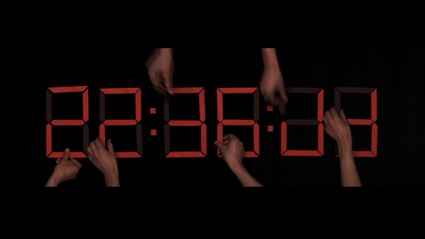 Torsten Lauschmann, Digital Clock (Growing Zeros) 2010. Still from film. Courtesy The Artist; Mary Mary, Glasgow
Torsten Lauschmann, Digital Clock (Growing Zeros) 2010. Still from film. Courtesy The Artist; Mary Mary, Glasgow
Anyway, i don’t know if the Samsung Art+ Prize is indeed ‘the UK’s first digital media art competition’, but it is remarkably good. The selection of artworks, that is. I’m far less enthusiastic about the way they are exhibited. First, there was no indication of the author and title next to the works, you have to guess or to wait for the credits at the end of the film, when they exist. Also i’d advise you navigate the rooms carefully. It’s so dark bench corners tend to hit your knees when you least expect them.
Most of the works are screen-based. The prize is sponsored by a manufacturer of TVs after all. There are even two 3D pieces to ensure that the audience will marvel at the flawless technology (as i did.)
I spent an hour and a half watching the works of 10 technologically-inspired artists. There is so much to watch and take in that i might have to go back again. I think i need to repeat here that the show is wonderful. Please, please, don’t miss it if you’re in London in the coming days.
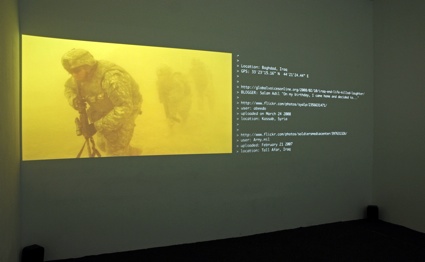 Thomson & Craighead, A Short Film about War, 2009. Courtesy of the artist
Thomson & Craighead, A Short Film about War, 2009. Courtesy of the artist
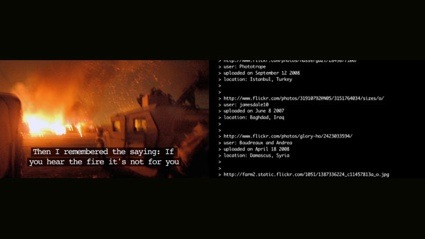 Thomson & Craighead, A Short Film about War, 2009. Courtesy of the artist
Thomson & Craighead, A Short Film about War, 2009. Courtesy of the artist
One of my favourite pieces is Thomson & Craighead‘s A short film about War. The two screen documentary artwork is made entirely from material found online and uploaded under Creative Commons (Copyleft) license. In ten minutes the movie travels around the world to war zones as captured through the collective eyes of Flickr, and as witnessed by military and civilian bloggers.
The documentary film is accompanied by a second screen that logs the source of the images, blog fragments and GPS locations of the content appearing in the documentary. The artists offer this tautology in an attempt to explore and reveal the way in which information changes as it is gathered, edited and then mediated through networked communications technologies or broadcast media, and how that changes and distorts meaning -especially for the world’s users of high speed broadband networks, who have become used to the treacherously persuasive panoptic view that Google Earth (and the worldwide web) appears to give us.
You can watch it online but the larger the screen the better.
Thomson & Craighead has a second work at BFI. Horizon is a clock made out of images accessed in realtime from webcams found in every time zone around the world. The images are rather unspectacular but ordered as a global electronic sundial as they are, they keep visitors fascinated for longer than you might expect.
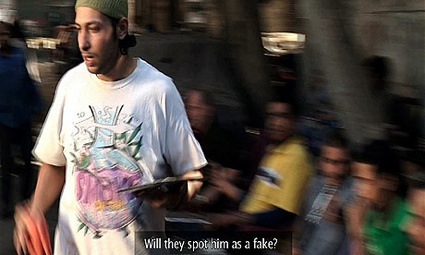 Neil Cummings, Lapdogs, 2009
Neil Cummings, Lapdogs, 2009
Neil Cummings’s Lapdogs is a satirical trailer for a show that would follow the format of the reality TV programme Faking It TV. Its main protagonist, an Egyptian street-cafe waiter, is taken on a crash-course in “how to become a successful international contemporary artist in one month.” From getting an ‘artist’ haircut to learning how to accept criticism.
The work pokes fun at the phenomenon of ordinary people turned stars thanks to reality tv shows as much as it lampoons the rock star status that artists have achieved in contemporary culture. But there’s more to the work. Since RDF media own the property rights to the Faking It TV format, the figure of the working class [the street waiter] is doubly exploited: as entertainment and as property.
Doug Fishbone is showing two works at BFI. They are as amusing as ever.
Untitled (Hypno Project) is another two-screen work. On the left, twelve people are watching the short video made using subliminal images that we see on the other screen. What makes their experience of the film different from ours is that these people have been hypnotized by a professional stage hypnotist, each having been given specific suggestions instructing them to respond in certain ways at different visual and aural cues.
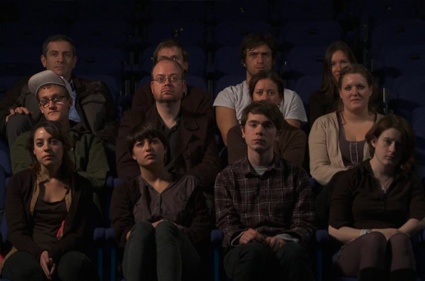 Douglas Fishbone, Untitled (Hypno Project), 2009
Douglas Fishbone, Untitled (Hypno Project), 2009
The results are startling. The group of people reacts in the most unexpected way following cues we know nothing about. One of the men was particularly excited by the frogs in the video.
Part 1
Part 2 is online as well.
Fishbone says, “Their reactions raise a broad range of questions about manipulation and behavioural conditioning, and the relativity of perception from one individual to the next. How natural are our responses to our environment, and how accurate are our perceptions?”
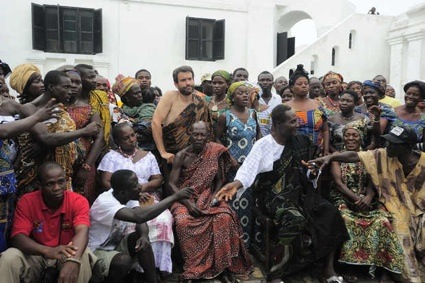 Doug Fishbone, Still from Elmina (Fight), 2010. Photo by Thierry Bal. D. Fishbone. Courtesy of the Artist
Doug Fishbone, Still from Elmina (Fight), 2010. Photo by Thierry Bal. D. Fishbone. Courtesy of the Artist
Another of Fishbone’s film was selected for the prize. Elmina stars the very white and very American artist in an otherwise completely Ghanaian production. The film will be released as a low-cost mass-market DVD and VCD in Africa and on African immigrant markets, The rest of us will be able to buy it as a limited edition in the art world. (i wrote about it last year.)
Torsten Lauschmann is showing Digital Clock (Growing Zeros). I can’t remember how many artistic versions of the digital clock i’ve seen over the past few years but this one is as good as any. Have a look:
A couple more images of the works selected for the Samsung Art + Prize:
![]() Semiconductor, Magnetic Movie, 2007. Courtesy of Semiconductor
Semiconductor, Magnetic Movie, 2007. Courtesy of Semiconductor
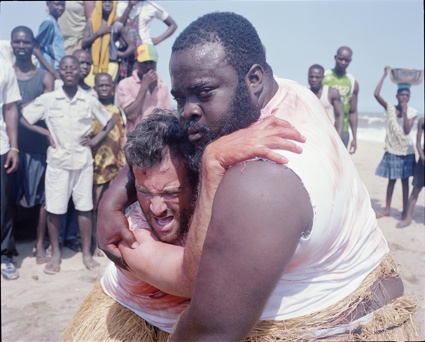 Doug Fishbone, Still from Elmina (Fight), 2010. Photo by Thierry Bal. D. Fishbone. Courtesy of the Artist
Doug Fishbone, Still from Elmina (Fight), 2010. Photo by Thierry Bal. D. Fishbone. Courtesy of the Artist
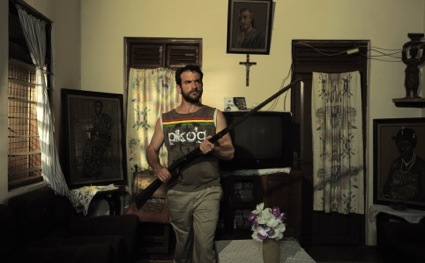 Doug Fishbone, Elmina, 2010, production still. Photo by Thierry Ball. Courtesy the artist and ROKEBY, London
Doug Fishbone, Elmina, 2010, production still. Photo by Thierry Ball. Courtesy the artist and ROKEBY, London
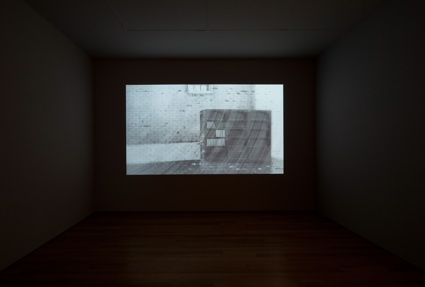 Hiraki Sawa, Installation shot: Did I?, 2011. Courtesy of the Artist
Hiraki Sawa, Installation shot: Did I?, 2011. Courtesy of the Artist
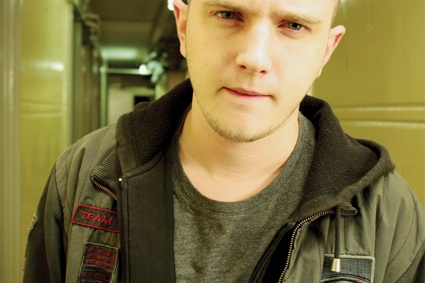 Iain Forsyth & Jane Pollard, Walking After Acconci (Redirected Approaches) 2005. (Production still) Photograph: Anne Worthington. Courtesy of the artists and Kate MacGarry, London
Iain Forsyth & Jane Pollard, Walking After Acconci (Redirected Approaches) 2005. (Production still) Photograph: Anne Worthington. Courtesy of the artists and Kate MacGarry, London
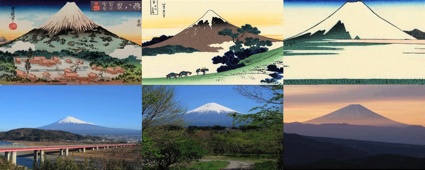 Erika Tan, The Syntactical Impossibility of Approaching with a Pure Heart, 2008. Courtesy of the artist
Erika Tan, The Syntactical Impossibility of Approaching with a Pure Heart, 2008. Courtesy of the artist
The Samsung Art+ Prize is on view at BFI Southbank in London from January 18 to 29th.
You can vote for the Samsung Art+ Prize Audience Award over here. Votes must be received by January 24th.
